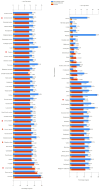MicroRNA-Based Liquid Biopsy for Cervical Cancer Diagnostics and Treatment Monitoring
- PMID: 39769036
- PMCID: PMC11678179
- DOI: 10.3390/ijms252413271
MicroRNA-Based Liquid Biopsy for Cervical Cancer Diagnostics and Treatment Monitoring
Abstract
Despite prevention strategies, cervical cancer remains a significant public health issue. Human papillomavirus plays a critical role in its development, and early detection is vital to improve patient outcomes. The incidence of cervical cancer is projected to rise, necessitating better diagnostic tools. Traditional screening methods like the cytological examination and human papillomavirus testing have limitations in sensitivity and reproducibility. Liquid-based cytology offers some improvements, but the need for more reliable and sensitive techniques persists, particularly for detecting precancerous lesions. Liquid biopsy is a non-invasive method that analyzes cancer-derived products in biofluids like blood, offering potential for real-time monitoring of tumor progression, metastasis, and treatment response. It can be based on detection of circulating tumor cells (CTCs), circulating free DNA (cfDNA), and microRNAs (miRNAs). This review particularly underlines the potential of microRNAs, which are transported by extracellular vesicles. Overall, this article underscores the importance of continued research into non-invasive diagnostic methods like liquid biopsy to enhance cervical cancer screening and treatment monitoring.
Keywords: biomarkers; cervical cancer; diagnosis; exosomes; extracellular vesicles; miRNA; microRNA; treatment monitoring.
Conflict of interest statement
The authors declare no conflicts of interest.
Figures






Similar articles
-
Circulating Liquid Biopsy Biomarkers in Glioblastoma: Advances and Challenges.Int J Mol Sci. 2024 Jul 21;25(14):7974. doi: 10.3390/ijms25147974. Int J Mol Sci. 2024. PMID: 39063215 Free PMC article. Review.
-
Liquid biopsy in ovarian cancer.Adv Clin Chem. 2020;97:13-71. doi: 10.1016/bs.acc.2020.01.001. Epub 2020 Feb 14. Adv Clin Chem. 2020. PMID: 32448432 Review.
-
Liquid biopsy = Individualized cancer management: Diagnosis, monitoring treatment and checking recurrence and metastasis.Oral Oncol. 2021 Dec;123:105588. doi: 10.1016/j.oraloncology.2021.105588. Epub 2021 Oct 28. Oral Oncol. 2021. PMID: 34744021
-
Cervical Cancer Genetic Profile through Circulating Tumor DNA: What Can We Learn from Blood?Biomolecules. 2024 Jul 10;14(7):825. doi: 10.3390/biom14070825. Biomolecules. 2024. PMID: 39062539 Free PMC article. Review.
-
Diagnosis, Monitoring, and Prognosis of Liquid Biopsy in Cancer Immunotherapy.Methods Mol Biol. 2023;2695:127-143. doi: 10.1007/978-1-0716-3346-5_9. Methods Mol Biol. 2023. PMID: 37450116 Review.
Cited by
-
Liquid biopsies in cancer.Mol Biomed. 2025 Mar 20;6(1):18. doi: 10.1186/s43556-025-00257-8. Mol Biomed. 2025. PMID: 40108089 Free PMC article. Review.
-
The biomarker potential of circPOLD1 and its binding protein YBX1 in cervical carcinogenesis.J Transl Med. 2025 May 4;23(1):506. doi: 10.1186/s12967-025-06494-3. J Transl Med. 2025. PMID: 40319271 Free PMC article.
References
-
- Singh D., Vignat J., Lorenzoni V., Eslahi M., Ginsburg O., Lauby-Secretan B., Arbyn M., Basu P., Bray F., Vaccarella S. Global estimates of incidence and mortality of cervical cancer in 2020: A baseline analysis of the WHO Global Cervical Cancer Elimination Initiative. Lancet Glob. Health. 2023;11:e197–e206. doi: 10.1016/S2214-109X(22)00501-0. - DOI - PMC - PubMed
-
- Gates A., Pillay J., Reynolds D., Stirling R., Traversy G., Korownyk C., Moore A., Thériault G., Thombs B.D., Little J., et al. Screening for the prevention and early detection of cervical cancer: Protocol for systematic reviews to inform Canadian recommendations. Syst. Rev. 2021;10:2. doi: 10.1186/s13643-020-01538-9. - DOI - PMC - PubMed
-
- World Health Organization . Global Strategy to Accelerate the Elimination of Cervical Cancer as a Public Health Problem. World Health Organization; Geneva, Switzerland: 2020. 52p

